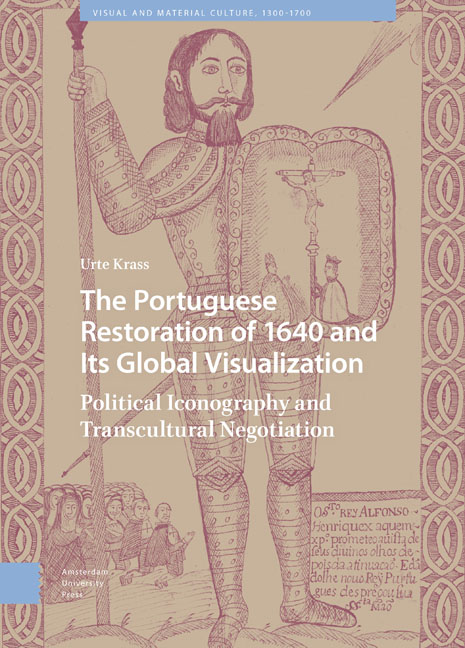 The Portuguese Restoration of 1640 and Its Global Visualization
The Portuguese Restoration of 1640 and Its Global Visualization Book contents
- Frontmatter
- Contents
- List of Illustrations
- Acknowledgments
- Introduction
- 1 Signs, Miracles, and Conspiratorial Images
- 2 The Lisbon Miracle of the Crucifix (1 December 1640)
- 3 The New King’s Oath (15 December 1640)
- 4 Acclamations
- 5 Lisbon
- 6 Images in Diplomatic Service
- 7 The Imaculada as Portugal’s Patroness
- 8 The Funeral Apparatus of John IV (November 1656)
- 9 The Drawings in the Treatise of António de São Thiago (Goa 1659)
- 10 Ivory Good Shepherds as Visualizations of the Portuguese Restoration
- Conclusion
- Bibliography
- Index
5 - Lisbon
Published online by Cambridge University Press: 13 February 2024
- Frontmatter
- Contents
- List of Illustrations
- Acknowledgments
- Introduction
- 1 Signs, Miracles, and Conspiratorial Images
- 2 The Lisbon Miracle of the Crucifix (1 December 1640)
- 3 The New King’s Oath (15 December 1640)
- 4 Acclamations
- 5 Lisbon
- 6 Images in Diplomatic Service
- 7 The Imaculada as Portugal’s Patroness
- 8 The Funeral Apparatus of John IV (November 1656)
- 9 The Drawings in the Treatise of António de São Thiago (Goa 1659)
- 10 Ivory Good Shepherds as Visualizations of the Portuguese Restoration
- Conclusion
- Bibliography
- Index
Summary
Abstract: It is not only due to the destruction of the city of Lisbon by the earthquake of 1755 that we find hardly any architectural or urban planning traces of the Restoration. Other reasons for this void are the financial strain placed on the new dynasty by the Restoration War as well as the problem that many of the artists and architects who had previously worked in Portugal had become suspect through their cooperation with the Spanish Habsburgs. Furthermore, a conscious decision was made to continue using buildings that had been erected under the Castilian rulers and thus to “rewrite” them. The chapter discusses the difficulties of art patronage for a new dynasty that had to situate itself between tradition and innovation.
Keywords: Lisbon, Restoration monuments, architecture, royal palace chapel, central plan buildings
Breaks and Continuities: The Absence of the Monumental
We learn from Luís de Moura Sobral that in order to legitimize his rule, John IV initiated “an immense propaganda campaign using all available means and media”—an assessment that arguably is somewhat exaggerated. The principle media used were printed texts and images. Much of this material was printed in Paris, or else in London, as was the Lusitania Liberata of 1645, whose engravings rendered it the most ambitious work promulgating the Restoration in iconographical terms. About how the new power structures were visualized in Lisbon, we know relatively little. Has much been lost during the 1755 earthquake and fire of the city? Or can we assume that this branch of the “propaganda campaign” received relatively little attention by the king and his advisors? This is hinted at in a treatise of 1652 entitled Arte de furtar (Art of stealing). In an entirely nonironic way, the text with this great title is dedicated to King John IV and is committed to furthering his memory. The author, presumably the Jesuit Manuel da Costa, recommends that the king, among other things, place statues on Lisbon's rossios and squares. This had, then, apparently not been done twelve years after the revolt. In the years after 1640 hardly any use was in fact made of Lisbon's space to visualize the Restoration. The monument we see today on the Praça dos Restauradores, consisting of an obelisk flanked by the personifications of Independence and Victory, was dedicated in 1886.
- Type
- Chapter
- Information
- The Portuguese Restoration of 1640 and Its Global VisualizationPolitical Iconography and Transcultural Negotiation, pp. 201 - 212Publisher: Amsterdam University PressPrint publication year: 2023


